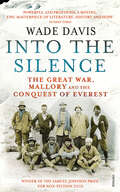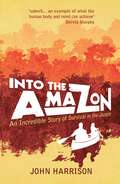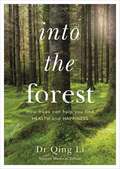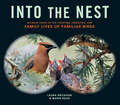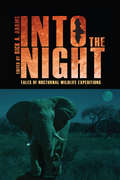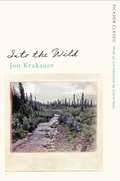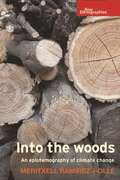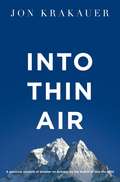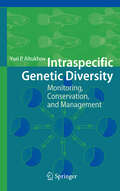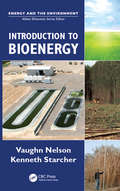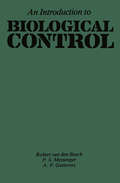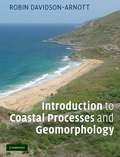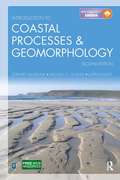- Table View
- List View
Into The Silence: The Great War, Mallory and the Conquest of Everest
by Wade Davis‘The price of life is death’ For Mallory, as for all of his generation, death was but ‘a frail barrier that men crossed, smiling and gallant, every day’. As climbers they accepted a degree of risk unimaginable before the war. What mattered now was how one lived, and the moments of being alive. While the quest for Mount Everest may have begun as a grand imperial gesture, it ended as a mission of revival for a country and a lost generation bled white by war. In a monumental work of history and adventure, Davis asks not whether George Mallory was the first to reach the summit of Everest, but rather why he kept climbing on that fateful day.
Into the Amazon: An Incredible Story of Survival in the Jungle
by John HarrisonIn 1950, a young French explorer entered deep jungle in Brazil and was never seen again. Inspired by that explorer's diary, John and Heather Harrison paddled their canoe into some of the remotest parts of the Amazon. This is the incredible story of their struggle to keep their sanity and marriage intact in one of the most hostile places on earth.
Into the Forest: How Trees Can Help You Find Health and Happiness
by Dr Qing LiHumans are increasingly becoming an indoor species. We spend 90 per cent of our life indoors. And, on average, we dedicate eight hours a day looking at screens. Our increasingly domestic lives are having huge consequences to our health. In Into the Forest, Immunologist and Forest Medicine expert, Dr Qing Li, examines the unprecedented benefits of the world's largest natural health resource: the great outdoors.Applying cutting-edge research and emerging science, Dr Li explores the inherent connection between nature and improved wellbeing. This practical guide will help you overcome some of life's most problematic health issues, including how to: · reduce blood pressure; · lower stress;· improve energy levels;· and boost the immune system. From mindful strolls in your local park to listening to the wind, from watching the sunset to walking barefoot in the grass, Dr Li reveals the life-improving advantages of spending time around trees, for a healthier and happier you.
Into the Nest: Intimate Views of the Courting, Parenting, and Family Lives of Familiar Birds
by Laura Erickson Marie ReadDocumentary photography and intriguing facts provide a close encounter with the domestic lives of North American birds found in backyards, city neighborhoods, forests, fields, and waterways, from first flirtation to the final fledgling&’s departure from the nest.
Into the Night: Tales of Nocturnal Wildlife Expeditions
by Rick AdamsThis entertaining collection of essays from professional scientists and naturalists provides an enlightening look at the lives of field biologists with a passion for the hidden world of nocturnal wildlife. Into the Night explores the harrowing, fascinating, amusing, and largely unheard personal experiences of scientists willing to forsake the safety of daylight to document the natural history of these uniquely adapted animals. Contributors tell of confronting North American bears, cougars, and rattlesnakes; suffering red ctenid spider bites in the tropical rain forest; swimming through layers of feeding-frenzied hammerhead sharks in the Galapagos; evading the wrath of African bull elephants in South Africa; and delighting in the curious and gentle nature of foxes and unconditional acceptance by a family of owls. They describe “fire in the sky” across a treeless tundra, a sea ablaze with bioluminescent algae, nighttime earthquakes on the Pacific Rim, and hurricanes and erupting volcanoes on a Caribbean island. Into the Night reveals rare and unexpected insights into nocturnal field research, illuminating experiences, discoveries, and challenges faced by intrepid biologists studying nature’s nightly marvels across the globe. This volume will be of interest to scientists and general readers alike.
Into the Peatlands: A Journey Through the Moorland Year
by Robin A. CrawfordIn this book Robin A. Crawford explores the peatlands of Lewis. He explains how they have come to be and also considers how peat has been used for millennia, principally as a fuel but also, amongst other things, as a key element in the whisky-making process. In describing the seasonal processes of cutting, drying, stacking, storing and burning, he reveals one of the key rhythms of island life, but his study goes well beyond this to include many other aspects, including the wildlife and folklore associated with these lonely, watery places. Widening his gaze to other peatlands in the country, he also reflects on the historical and cultural importance that peat has played, and continues to play, in the story of Scotland.
Into the River of Life: A biography of Ian Player
by Graham LinscottInto the River of Life is the story of Dr Ian Player, internationally recognised environmentalist and conservationist. But Player is a man of many facets and contradictions, not just a ranger: a man of culture and the arts, a deep thinker and Jungian, an irascible campaigner and a maverick. He is a writer, a lecturer and international diplomat and a deeply committed man to all he believes in. Player was a young man when he pioneered the Duzi Canoe Marathon in 1950. He expected to see an abundance of wildlife along the river bank but, to his dismay, he saw almost none. So began an epic journey to fight for nature conservation. He joined the Natal Parks Board in 1952 and spearheaded two initiatives. He pioneered Operation Rhino, which succeeded in saving the white rhino from extinction, and he obtained protected status for the Umfolozi and St Lucia Wilderness areas - a first in South Africa and on the African continent. He also founded the Wilderness Leadership School during the troubled days of apartheid, a multi-racial and experiential program, which was to spawn a global network of conservationists committed to saving wilderness and wildlife throughout the world. His work has been recognised globally and among his numerous accolades he has been awarded Knight of the Order of the Golden Ark and the Decoration for Meritorious Service, the highest civilian decoration in South Africa. He lives with his wife near Howick in Natal and is the brother of golfing legend Gary Player.
Into the Wild: 30 Books Complete Teacher's Kit (Picador Classic)
by Jon KrakauerThe true story of college graduate Chris McCandless, who decided to walk away from the only life he ever knew and enter the wild.
Into the Wild: 30 Books Complete Teacher's Kit (Picador Classic #78)
by Jon KrakauerJon Krakauer's Into the Wild examines the true story of Chris McCandless, a young man who walked deep into the Alaskan wilderness and whose SOS note and emaciated corpse were found four months later.In April 1992, Chris McCandless set off alone into the Alaskan wild. He had given his savings to charity, abandoned his car and his possessions, and burnt the money in his wallet, determined to live a life of independence. Just four months later, Chris was found dead. An SOS note was taped to his makeshift home, an abandoned bus.In piecing together the final travels of this extraordinary young man's life, Jon Krakauer writes about the heart of the wilderness, its terribly beauty and its relentless harshness. Into the Wild is a modern classic of travel writing, and a riveting exploration of what drives some of us to risk more than we can afford to lose.From the author of Under the Banner of Heaven and Into Thin Air. A film adaptation of Into the Wild was directed by Sean Penn and starred Emile Hirsch and Kristen Stewart.'It may be nonfiction, but Into the Wild is a mystery of the highest order.' – Entertainment Weekly
Into the woods: An epistemography of climate change (New Ethnographies)
by Meritxell Ramírez-i-OlléThis book is a detailed exploration of the working practices of a community of scientists exposed in public, and of the making of scientific knowledge about climate change in Scotland. For four years, the author joined these scientists in their sampling expeditions into the Caledonian forests, observed their efforts in the laboratory to produce data from wood samples and followed their discussions of a graph showing the evolution of the Scottish temperature over the past millennium in conferences, workshops and peer-review journals. This epistemography of climate change is of broad social and academic relevance – both for its contextualised treatment of a key contemporary science, and for its original formulation of a methodology for investigating expertise.
Into the woods: An epistemography of climate change (New Ethnographies)
by Meritxell Ramírez-i-OlléThis book is a detailed exploration of the working practices of a community of scientists exposed in public, and of the making of scientific knowledge about climate change in Scotland. For four years, the author joined these scientists in their sampling expeditions into the Caledonian forests, observed their efforts in the laboratory to produce data from wood samples and followed their discussions of a graph showing the evolution of the Scottish temperature over the past millennium in conferences, workshops and peer-review journals. This epistemography of climate change is of broad social and academic relevance – both for its contextualised treatment of a key contemporary science, and for its original formulation of a methodology for investigating expertise.
Into Thin Air: A Personal Account of the Everest Disaster (Picador Collection #111)
by Jon KrakauerJon Krakauer's Into Thin Air is the true story of a 24-hour period on Everest, when members of three separate expeditions were caught in a storm and faced a battle against hurricane-force winds, exposure, and the effects of altitude, which ended in the worst single-season death toll in the peak's history. In March 1996, Outside magazine sent veteran journalist and seasoned climber Jon Krakauer on an expedition led by celebrated Everest guide Rob Hall. Despite the expertise of Hall and the other leaders, by the end of summit day, eight people were dead. Krakauer's book is at once the story of the ill-fated adventure and an analysis of the factors leading up to its tragic end. Written within months of the events it chronicles, Into Thin Air clearly evokes the majestic Everest landscape. As the journey up the mountain progresses, Krakauer puts it in context by recalling the triumphs and perils of other Everest trips throughout history. The author's own anguish over what happened on the mountain is palpable as he leads readers to ponder timeless questions.One of the inspirations for the major motion picture Everest, starring Jake Gyllenhaal and Keira Knightley.'Into Thin Air ranks among the great adventure books of all time.' - Wall Street Journal'A harrowing tale of the perils of high-altitude climbing, a story of bad luck and worse judgment and of heartbreaking heroism.' - People
Into Wild Mongolia
by George B. SchallerExplore the wonders of wild Mongolia through the eyes of a distinguished field biologist Mongolia became a satellite of the Soviet Union in the mid-1920s, and for nearly seven decades effectively closed its doors to the outside world. Biologist George Schaller initially visited the country in 1989, and was one of the first Western scientists allowed to study and assess the conservation status of Mongolia’s many unique, native wildlife species. Schaller made a number of trips from 1989 to 2018 in collaboration with Mongolian and American scientists, witnessing Mongolia’s recovery and transition to a market economy after the collapse of the Soviet Union. This informative and fascinating new book provides a firsthand account of Schaller’s time in this little-known and remote country, where he studied and helped develop conservation initiatives for the snow leopard, Gobi bear, wild camel, and Mongolian gazelle, among other species. Featuring magnificent photographs from his travels, the book offers a critical, at times inspiring contribution for those who treasure wildlife, as well as a fresh perspective on the natural beauty of the region, which encompasses steppes, mountains, and the Gobi Desert.
Intraspecific Genetic Diversity: Monitoring, Conservation, and Management
by Yuri Petrovich AltukhovPopulation and evolutionary genetics have been quickly developing ?elds of biological research over the past decades. This book compiles our current understanding of genetic processes in natural populations. In addition, the book provides the author’s original ideas and concepts based on the data obtained by himself and his close coworkers. The author introduces his pioneering concept of population genetic stability,and much of thebook is concerned with the factors and conditions of such stability. Why does genetic stability matter so much? Altukhov argues that the sustainable use of natural resources, including genetic resources of popu- tions, critically depends on the maintenance of their stability. The preser- tion of well-adapted genetic characteristics from one generation to the next is essential for this stability. Traditionally, population genetics has been - cusedonevolution andthe role of evolutionary factorsinshapinggenetic structures of populations. While the idea of a population as a dynamic unit of evolution has been widely accepted, the signi?cance of genetic stability and its implications for the long-term survival of populations and species have not been fully appreciated.
The Intrinsic Value of Endangered Species (Routledge Studies in Ethics and Moral Theory)
by Ian A. SmithWhy save endangered species without clear aesthetic, economic, or ecosystemic value? This book takes on this challenging question through an account of the intrinsic goods of species. Ian A. Smith argues that a species’ intrinsic value stems from its ability to flourish—its organisms continuing to reproduce successfully and it avoiding extinction—which helps to demonstrate a further claim, that humans ought to preserve species that we have endangered. He shows our need to exercise humility in our relations with endangered species through the preservation of their intrinsic goods, which in turn rectifies our degradation of their importance. Unique in its appeal to virtue ethics and to species concepts, The Intrinsic Value of Endangered Species is an important resource for scholars working in environmental ethics and the philosophy of biology.
The Intrinsic Value of Endangered Species (Routledge Studies in Ethics and Moral Theory)
by Ian A. SmithWhy save endangered species without clear aesthetic, economic, or ecosystemic value? This book takes on this challenging question through an account of the intrinsic goods of species. Ian A. Smith argues that a species’ intrinsic value stems from its ability to flourish—its organisms continuing to reproduce successfully and it avoiding extinction—which helps to demonstrate a further claim, that humans ought to preserve species that we have endangered. He shows our need to exercise humility in our relations with endangered species through the preservation of their intrinsic goods, which in turn rectifies our degradation of their importance. Unique in its appeal to virtue ethics and to species concepts, The Intrinsic Value of Endangered Species is an important resource for scholars working in environmental ethics and the philosophy of biology.
Introduction to Bioenergy
by Vaughn C. Nelson Kenneth L. StarcherExplore a Major Component of Renewable Energy Introduction to Bioenergy takes a look at energy from biomass (thermal energy, power, liquid fuels, and biogas) and envisions a sustainable future fueled by renewable energy. From production to conversion to heat, power, and biofuel, this book breaks down the science of bioenergy and explains the major processes for its production, conversion, and use. Covers Solar Energy, Bioenergy, and Biomass Resources The book begins with an introduction to solar energy (the source of bioenergy) and then moves on to describe bioenergy, biomass, chemical conversion, and the renewable energy processes involved. The authors cover measurement energy parameters, analysis of data, and the prediction of energy production for different bio products. They also consider the institutional, environmental, and economic concerns surrounding bioenergy. An all-inclusive resource covering a rapidly-advancing field, this book: Explores the impact of climate change and global warming on the production of biomass Describes the positive and negative effects of biomass production on ecosystems and biodiversity Illustrates the use of biomass for the production of electricity Considers the replacement of fossil fuels with biofuels, biofuel production, and emerging technologies Addresses institutional and environmental issues relevant to bioenergy Discusses factors impacting the economic feasibility of renewable energy systems Introduction to Bioenergy defines major processes for the production, conversion, and use of bioenergy. A book suitable for coursework or self-study, this essential work serves students and practicing professionals in the renewable energy, environmental science, agriculture engineering, and biology fields.
Introduction to Bioenergy
by Vaughn C. Nelson Kenneth L. StarcherExplore a Major Component of Renewable Energy Introduction to Bioenergy takes a look at energy from biomass (thermal energy, power, liquid fuels, and biogas) and envisions a sustainable future fueled by renewable energy. From production to conversion to heat, power, and biofuel, this book breaks down the science of bioenergy and explains the major processes for its production, conversion, and use. Covers Solar Energy, Bioenergy, and Biomass Resources The book begins with an introduction to solar energy (the source of bioenergy) and then moves on to describe bioenergy, biomass, chemical conversion, and the renewable energy processes involved. The authors cover measurement energy parameters, analysis of data, and the prediction of energy production for different bio products. They also consider the institutional, environmental, and economic concerns surrounding bioenergy. An all-inclusive resource covering a rapidly-advancing field, this book: Explores the impact of climate change and global warming on the production of biomass Describes the positive and negative effects of biomass production on ecosystems and biodiversity Illustrates the use of biomass for the production of electricity Considers the replacement of fossil fuels with biofuels, biofuel production, and emerging technologies Addresses institutional and environmental issues relevant to bioenergy Discusses factors impacting the economic feasibility of renewable energy systems Introduction to Bioenergy defines major processes for the production, conversion, and use of bioenergy. A book suitable for coursework or self-study, this essential work serves students and practicing professionals in the renewable energy, environmental science, agriculture engineering, and biology fields.
An Introduction to Biological Control
by A.P. Gutierrez P.S. Messenger R. van den BoschThis volume is a revision of Biological Control by R. van den Bosch and P. S. Messenger, originally published by Intext Publishers. In the revision, I have attempted to keep the original theme, and to update it with current research findings and new chapters or sections on insect pathology, microbial control of weeds and plant pathogens, population dynamics, integrated pest management, and economics. The book was written as an undergraduate text, and not as a complete review of the subject area. Various more comprehen sive volumes have been written to serve as handbooks for the experts. This book is designed to provide a concise overview of the complex and valuable field of biological control and to show the relationships to the developing concepts of integrated pest management. Population regulation of pests by natural enemies is the major theme of the book, but other biological methods of pest control are also discussed. The chapter on population dynamics assumes a precalculus-level knowledge of mathematics. Author names of species are listed only once in the text, but all are listed in the Appendix. Any errors or omissions in this volume are my sole responsibility. A. P. Gutierrez Professor of Entomology Division of Biological Control University of California, Berkeley vii Acknowledgments Very special thanks must be given to my colleagues, Professors C. B. Huffaker and L. E. Caltagirone, for the very thorough review they provided and for the many positive suggestions they gave. Dr.
An Introduction to Climate Change Economics and Policy (Routledge Textbooks in Environmental and Agricultural Economics)
by Elissaios Papyrakis Felix R. FitzRoyThe 2nd edition of An Introduction to Climate Change Economics and Policy explains the key scientific, economic and policy issues related to climate change in a completely up-to-date introduction for anyone interested, and students at all levels in various related courses, including environmental economics, international development, geography, politics and international relations. FitzRoy and Papyrakis highlight how economists and policymakers often misunderstand the science of climate change, underestimate the growing threat to future civilization and survival and exaggerate the costs of radical measures needed to stabilize the climate. In contrast, they show how direct and indirect costs of fossil fuels – particularly the huge health costs of local pollution – actually exceed the investment needed for transition to an almost zero carbon economy in two or three decades using available technology.
An Introduction to Climate Change Economics and Policy (Routledge Textbooks in Environmental and Agricultural Economics)
by Elissaios Papyrakis Felix R. FitzRoyThe 2nd edition of An Introduction to Climate Change Economics and Policy explains the key scientific, economic and policy issues related to climate change in a completely up-to-date introduction for anyone interested, and students at all levels in various related courses, including environmental economics, international development, geography, politics and international relations. FitzRoy and Papyrakis highlight how economists and policymakers often misunderstand the science of climate change, underestimate the growing threat to future civilization and survival and exaggerate the costs of radical measures needed to stabilize the climate. In contrast, they show how direct and indirect costs of fossil fuels – particularly the huge health costs of local pollution – actually exceed the investment needed for transition to an almost zero carbon economy in two or three decades using available technology.
Introduction To Coastal Processes And Geomorphology
by Robin Davidson-ArnottWritten for undergraduate students studying coastal geomorphology, this is the complete guide to the processes at work on our coastlines and the features we see in coastal systems across the world. Accessible to students from a range of disciplines, the quantitative approach of this book helps to build a solid understanding of wave and current processes that shape coastlines. The resulting processes of erosion, transport and deposition and the features they create are clearly explained, with over 400 illustrations and photographs. From sandy beaches to coral reefs, the major coastal features are related to contemporary processes and to sea-level changes over the past 25,000 years. Key equations describing or predicting measurements from instruments used to map these processes are all presented in this wide-ranging overview. Davidson-Arnott completes this teaching package with online material that brings the subject to life, including videos of coastal processes and virtual field trips.
Introduction to Coastal Processes and Geomorphology (PDF)
by Michael G. Hughes Jasper Knight Gerhard MasselinkThe world's coastlines represent a myriad of dynamic and constantly changing environments. Heavily settled and intensely used areas, they are of enormous importance to humans and understanding how they are shaped and change is crucial to our future. Introduction to Coastal Processes and Geomorphologybegins by discussing coastal systems and shows how these systems link to the processes examined in detail throughout the book. These include the morphodynamic paradigm, tides, waves and sediment transport. Later chapters explore fluvial deltas, estuaries, beaches and barriers, coastal sand dunes and geologically-influenced coasts such as cliffs, coral reefs and atolls. A new chapter addresses the forward-facing aspect of coastal morphodynamics, including the ways in which coasts respond to rapid climate changes such as present day global warming. Also new to this second edition is a chapter on future coasts which considers the wider effects of coastal change on other important aspects of coastal systems, including ecology, management, socio-cultural activities, built and natural heritage, and archaeology. Case studies using examples from around the world illustrate theory in practice and bring the subject to life. Each chapter starts by outlining the 'aims' and questions at the end allow you to track your progress.
Introduction to Coastal Processes and Geomorphology, Second Edition
by Gerd Masselink Michael Hughes Jasper KnightThe world's coastlines represent a myriad of dynamic and constantly changing environments. Heavily settled and intensely used areas, they are of enormous importance to humans and understanding how they are shaped and change is crucial to our future.Introduction to Coastal Processes and Geomorphologybegins by discussing coastal systems and shows how these systems link to the processes examined in detail throughout the book. These include the morphodynamic paradigm, tides, waves and sediment transport. Later chapters explore fluvial deltas, estuaries, beaches and barriers, coastal sand dunes and geologically-influenced coasts such as cliffs, coral reefs and atolls. A new chapter addresses the forward-facing aspect of coastal morphodynamics, including the ways in which coasts respond to rapid climate changes such as present day global warming. Also new to this second edition is a chapter on future coasts which considers the wider effects of coastal change on other important aspects of coastal systems, including ecology, management, socio-cultural activities, built and natural heritage, and archaeology. Case studies using examples from around the world illustrate theory in practice and bring the subject to life. Each chapter starts by outlining the 'aims' and questions at the end allow you to track your progress. This book is accompanied by additional resources online at www.hodderplus.com/geography including: Answers to the questions available to download as MP3 files Expanded case studies with colour photos, links to relevant websites and a map link to pinpoint the case study location Interactive multiple choice questions and worked examplesThe ebook edition is in VitalBookTM Bookshelf - an ebook reader which allows you to:download the ebook to your computer or access it anywhere with an internet browser search the full text of all of the ebooks that you hold on your bookshelf for instant access to the information you needmake and share notes and highlights on your ebookscopy and print text and figurescustomize your view by changing font size and layout.
Introduction to Coastal Processes and Geomorphology, Second Edition
by Gerd Masselink Michael Hughes Jasper KnightThe world's coastlines represent a myriad of dynamic and constantly changing environments. Heavily settled and intensely used areas, they are of enormous importance to humans and understanding how they are shaped and change is crucial to our future.Introduction to Coastal Processes and Geomorphologybegins by discussing coastal systems and shows how these systems link to the processes examined in detail throughout the book. These include the morphodynamic paradigm, tides, waves and sediment transport. Later chapters explore fluvial deltas, estuaries, beaches and barriers, coastal sand dunes and geologically-influenced coasts such as cliffs, coral reefs and atolls. A new chapter addresses the forward-facing aspect of coastal morphodynamics, including the ways in which coasts respond to rapid climate changes such as present day global warming. Also new to this second edition is a chapter on future coasts which considers the wider effects of coastal change on other important aspects of coastal systems, including ecology, management, socio-cultural activities, built and natural heritage, and archaeology. Case studies using examples from around the world illustrate theory in practice and bring the subject to life. Each chapter starts by outlining the 'aims' and questions at the end allow you to track your progress. This book is accompanied by additional resources online at www.hodderplus.com/geography including: Answers to the questions available to download as MP3 files Expanded case studies with colour photos, links to relevant websites and a map link to pinpoint the case study location Interactive multiple choice questions and worked examplesThe ebook edition is in VitalBookTM Bookshelf - an ebook reader which allows you to:download the ebook to your computer or access it anywhere with an internet browser search the full text of all of the ebooks that you hold on your bookshelf for instant access to the information you needmake and share notes and highlights on your ebookscopy and print text and figurescustomize your view by changing font size and layout.
